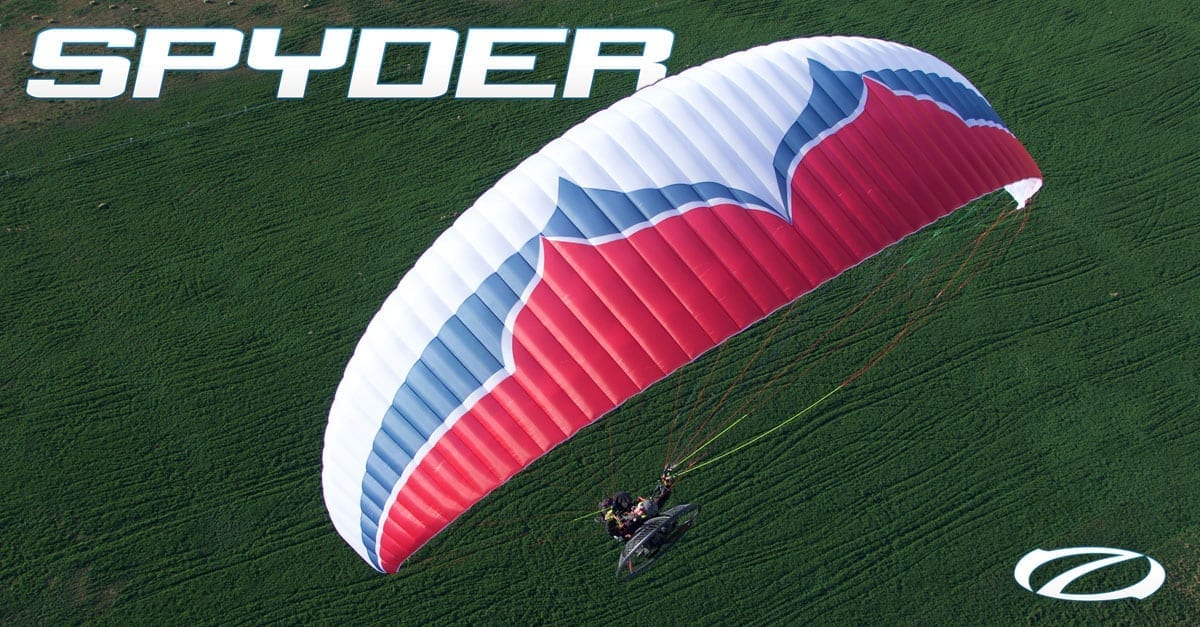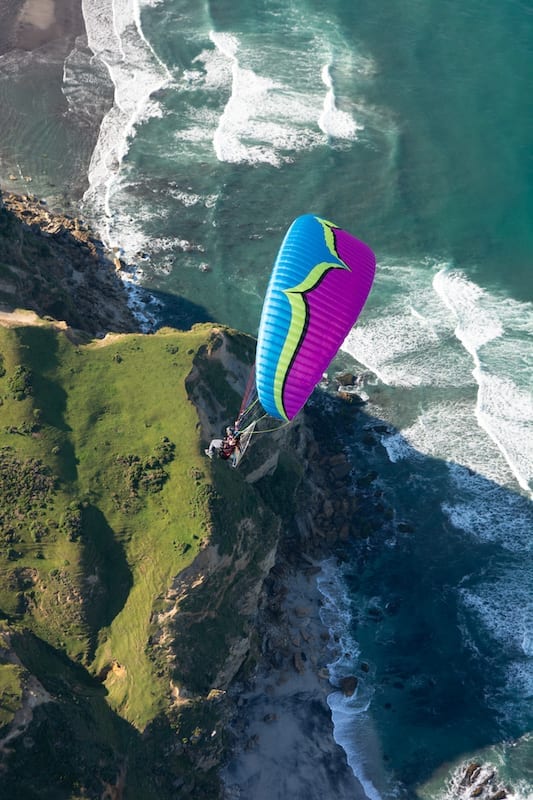

Spyder 3
The Spyder 3 is an advanced-technology beginner-reflex glider that offers speed and performance for cross country adventure-flying with the stability and ease-of-use of a beginner paramotor wing.
From Ozone:
The Spyder 3 offers massive improvemnets in handling, launch behavior, and top speed. The first things a Spyder pilot will notice is better inflation and launch characteristics (than it's predecessor), and significantly more agile and precise handling. The Spyder 3 is designed for pilots of all abilities, from newly qualified to advanced. It is a dedicate paramotor wing with a full reflex profile. Based on the Roadster 3, the Spyder 3 uses a carefully selected blend of lightweight cloths for the main surfaces and ribs, and optimized internal construction, reducing sail weight and pack volume. The lighter sail is a positive all-around, with easier launch, a more agile and responsive feel, and improved passive safety (reduced sail inertia).
Features
- Easy nil wind inflation
- Ease of use
- High cruise speed
- Very high top speed
- Stability in turbulent air
- Fun precise yet forgiving handling
- TST (tip steering)
- Shark Nose technology

For a list of all specifications, certifications, color options and downloads, please visit the manufacturer web site here.
Notes from the Fly Halo team:
The Roadster/Spyder series of beginner-oriented reflex gliders have set an absolute standard in the industry for many years in terms of high-speed and stable beginner wings. Here at Team Fly Halo, the Roadster/Spyder series accounts for about 50% of our new pilots' wing choices for good reason: They're stable/easy enough for a beginner, but fast enough that you won't grow out of it too quickly.
Ozone has hit another home run with the recent update to the Roadster3/Spyder3 in their ease-of-inflation/launch characteristics, stability, intuitive controls, and increased top speed. New tweaks in the sail structure/shape and line length mean a reduction of roll oscillations that the previous versions of both gliders were known for. This opens the glider up to even more potential beginner Roadster/Spyder pilots, and makes for a more comfortable flying experience on cross-country flights.
The difference of lighter weight
The Spyder 3 is essentially a lightweight Roadster 3, which has a couple of advantages that may or may not be important to some pilots. First, easier inflation characteristics come with lighter materials. We feel that the Roadster 3 is adequately easy to inflate, and unless you have a certain special circumstance (e.g. amputee foot-launching) or tricky flying locale (predominantly very high DA and zero wind conditions), the increased ease of inflation on the Spyder 3 is just sort of a "crutch" that isn't really needed for the average pilot.
The other big benefit to the lightweight variant (Spyder 3) is sportier handling. This isn't a feature that we feel beginners will appreciate until their 2nd or 3rd year of flying, and it may only serve to discourage the average skilled newb. However, this is an incredibly attractive feature for pilots who already cut their teeth on classic gliders, and are searching for a fun, sporty, but very safe reflex glider to transition to.

Is it for me?
Both the Roadster 3 and Spyder 3 are fast gliders. They have incredible speed range for a beginner gliders. This can be a good thing for many reasons, but the appeal to newbs is that it gives you the flexibility to progress into more advanced flying styles, and allows you to keep up with your more advanced flying buddies.
Our favorite benefit to the increased speed range of reflex gliders is that it gives you options if you get yourself into trouble. For example, if you take off and winds pick up, you'll have the airspeed to deal with the higher-than-anticipated headwinds to get yourself back to a safe landing. And in that high-wind landing scenario, that increased airspeed can help you land in a controlled fashion vs. hovering down or getting blown backwards. These are truly exceptional circumstances, but we like to be prepared.
On the downside, faster means that the glider makes lift at a higher speed, and takes a more refined technique to both launch and land safely. This can be a nightmare for a beginner if you're inappropriately weighted, have bad knees, have a low-power paramotor, live at higher elevations, are overweight, or have more gray hair than the average PPG newb.
Aside from launching and landing troubles, extra speed means that things happen quicker. Sticky situations get stickier if you're behind the curve, and it's an absolute tragedy when someone gets themselves hurt while flying a glider that is just too fast for their skillset. The other tragedy that more commonly happens with a glider that's too fast: flying becomes stressful and scary, and you get chased out of the sport without ever really having a fair shot at falling in love with it.
We typically like to err on the side of caution, and pick a smart, conservative setup to ensure your success and safety based on your aptitude. We are big believers in a thoughtful progression, and we tend to encourage pilots to spend their first year or two flying a classic glider and learning the active piloting concept prior to switching to the passive stability and insane performance of reflex wings. The benefit to this is that you map your reactions and instincts to fundamental piloting skills which are the very skills that save you in those uncommon, dangerous situations that we find ourselves in from time-to-time.
The great thing is, we've been doing this for a long time, and you don't have to make this decision on your own! Give us a call and tell us your story, we'll help you sort out the best possible setup given your physical characteristics and specific goals in PPG.
